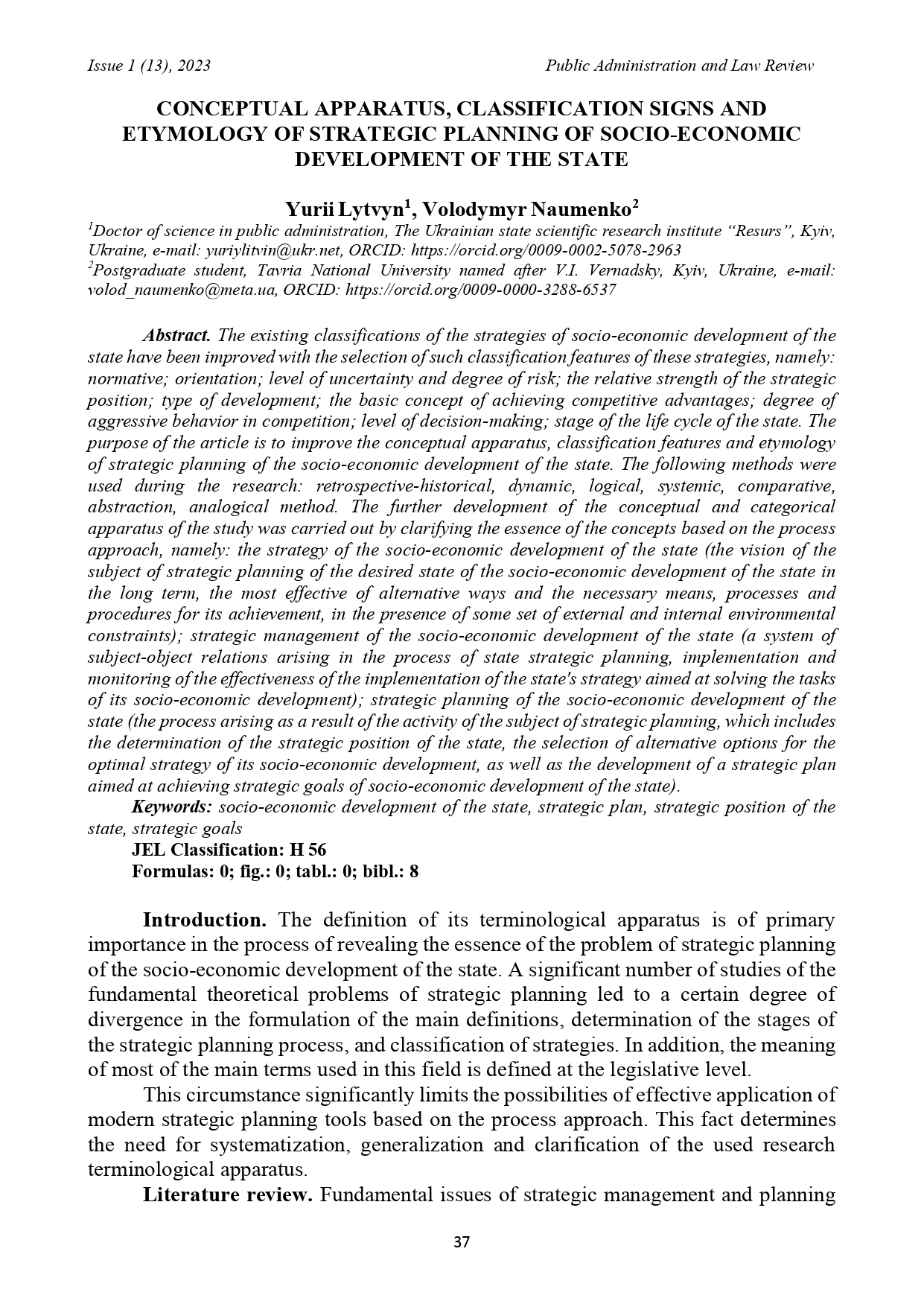CONCEPTUAL APPARATUS, CLASSIFICATION SIGNS AND ETYMOLOGY OF STRATEGIC PLANNING OF SOCIO-ECONOMIC DEVELOPMENT OF THE STATE
DOI:
https://doi.org/10.36690/2674-5216-2023-1-37Keywords:
socio-economic development of the state, strategic plan, strategic position of the state, strategic goalsAbstract
The existing classifications of the strategies of socio-economic development of the state have been improved with the selection of such classification features of these strategies, namely: normative; orientation; level of uncertainty and degree of risk; the relative strength of the strategic position; type of development; the basic concept of achieving competitive advantages; degree of aggressive behavior in competition; level of decision-making; stage of the life cycle of the state. The purpose of the article is to improve the conceptual apparatus, classification features and etymology of strategic planning of the socio-economic development of the state. The following methods were used during the research: retrospective-historical, dynamic, logical, systemic, comparative, abstraction, analogical method. The further development of the conceptual and categorical apparatus of the study was carried out by clarifying the essence of the concepts based on the process approach, namely: the strategy of the socio-economic development of the state (the vision of the subject of strategic planning of the desired state of the socio-economic development of the state in the long term, the most effective of alternative ways and the necessary means, processes and procedures for its achievement, in the presence of some set of external and internal environmental constraints); strategic management of the socio-economic development of the state (a system of subject-object relations arising in the process of state strategic planning, implementation and monitoring of the effectiveness of the implementation of the state's strategy aimed at solving the tasks of its socio-economic development); strategic planning of the socio-economic development of the state (the process arising as a result of the activity of the subject of strategic planning, which includes the determination of the strategic position of the state, the selection of alternative options for the optimal strategy of its socio-economic development, as well as the development of a strategic plan aimed at achieving strategic goals of socio-economic development of the state).
Downloads
References
Zhalilo, Ya. (2003) Economic strategy of the state: theory, methodology, practice, NISD, Kyiv, Ukraine
Mockler, R.J. (1992) Strategic Management: An Integrative Context-Specific Process. Harrisburg-London: Idea Group Publishing.
Chandler, A. D. (1961) Strategy and Structura, Boston, USA.
Ansoff, I. (1957) Strategies for Diversification, Cambridge: Harvard Business Review, pp. 113-124.
Barney, J.B. (1996) Gaining and Sustaining Competitive Advantage, New York, USA.
Kim, W.C., Mauborgne , R. (2005) Blue ocean strategy: how to create uncontested market space and make the competition irrelevant, Harvard Business School Press, Boston, USA.
Treacy, M. , Wiersema F. (1997) The Discipline of Market Leaders: Choose Your Customers, Narrow Your Focus, Dominate Your Market, Addison-Wesley: Basic Books, Boston, USA.
Shendel, D.E. , Hatten K.J. (1972) Business Policy or Strategic Management: A Broader View for an Emerging Discipline, Academy of Management Proceedings, pp. 371-378.

Downloads
Published
How to Cite
Issue
Section
License

This work is licensed under a Creative Commons Attribution-NoDerivatives 4.0 International License.





